Photosynthesis – Food Making Process in Plants
Important Questions on Photosynthesis – Food Making Process in Plants
The sun provides energy for all living things. Gurmeet wrote two statements to explain the above fact.
Statement 1: All autotrophs prepare their own food in the presence of sunlight.
Which of the following should be Statement 2?
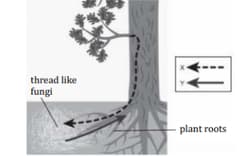
Parasite is an organism that lives in or on the body of another organism. It receives energy and nutrients from the host organism. Parasite does not give anything in return to its host. Is the group of fungi shown in the picture a type of parasite? Explain your answer.
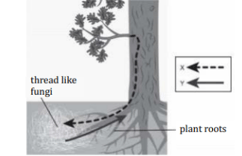
X and Y show the direction of flow of substances from one source to another.
Which substances move in X direction and which substances move in Y direction.
Which of the following organisms obtain nutrients from dead and decaying organisms?
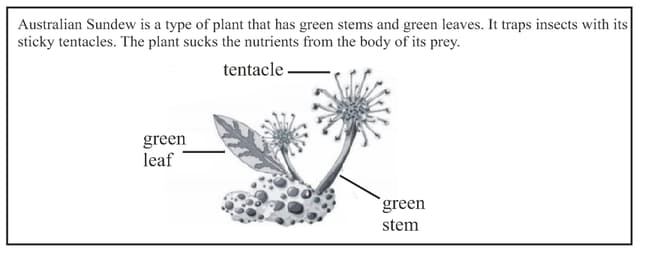
Australian Sundew is a part autotroph and part heterotroph.
Write two features of the plant that support this.
Jessy wanted to find out the conditions that best support the rotting of bread. The growth of coloured fluffy patches on the surface of bread confirms rotting. She kept four bread slices in different conditions for five days. The table below shows Jessy’s findings after five days.
| Bread slice | Where the slice is placed | Number of coloured fluffy patches after five days |
| Slice 1 | On wet cotton at 5 ℃ | Two patches |
| Slice 2 | On a dry plate at 30 ℃ | Six patches |
| Slice 3 | On wet cotton at 30 ℃ | Ten patches |
| Slice 4 | On a dry plate at 5 ℃ | No patch |
Which condition can best prevent rotting for a long time?
Jessy wanted to find out the conditions that best support the rotting of bread. The growth of coloured fluffy patches on the surface of bread confirms rotting. She kept four bread slices in different conditions for five days. The table below shows Jessy’s findings after five days.
| Bread slice | Where the slice is placed | Number of coloured fluffy patches after five days |
| Slice 1 | On wet cotton at 5 ℃ | Two patches |
| Slice 2 | On a dry plate at 30 ℃ | Six patches |
| Slice 3 | On wet cotton at 30 ℃ | Ten patches |
| Slice 4 | On a dry plate at 5 ℃ | No patch |
Which microorganism forms the coloured fluffy patches on the bread?
(Select the correct answer from the following options: Algae/Fungi/Virus)
We often find green slimy layers on the surface of ponds. The layers are formed by tiny organisms that make their own food. Which of these is/are true about the organisms?
Radhika wants to find out whether a purple plant can make its own food. She keeps a purple plant in sunlight for four days.
Which other type of coloured plant should Radhika keep as part of her study to compare with the purple plant?
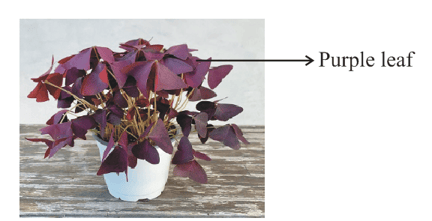
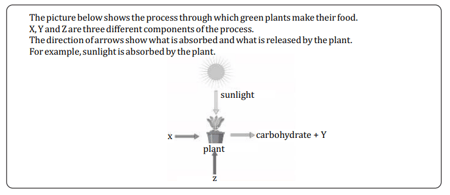
The equation below shows how green plants make their own food.
Carbon dioxide + Water Carbohydrate + oxygen
What does X, Y and Z stand for in the picture above?
| X | Y | Z |
| A. Carbon dioxide | Water | Oxygen |
| B. Water | Oxygen | Carbon dioxide |
| C. Oxygen | Water | Carbon dioxide |
| D. Carbon dioxide | Oxygen | Water |
What will happen if you coat a leaf with wax?
Differentiate between autotrophs and heterotroph.
Plants, respire, excrete and reproduce, but they do not digest food. Why?
All plants with green leaves, from the tiniest mosses to big woody trees, synthesise, or create, their own food through photosynthesis. All heterotrophs depend on plants for their food. Can you explain how plants produce so much food that they are able to feed other organisms that are dependent on them?
Nilam took a destarched potted plant and set up an experiment as shown in the figure. She left the plant in sunlight for a few hours and then tested leaves A and B for starch. Leaf A did not give a starch test, while leaf B showed the presence of starch. What is proved by this experiment?
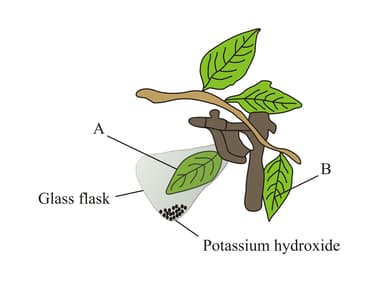
The image below displays fungi that resemble threads and are found close to some plants. The roots of the plant are encircled and pierced by the fungi. It aids the plant's ability to absorb water and minerals from the soil. The fungi receive carbohydrates from the plant. An organism known as a parasite inhabits or grows on the body of another organism. It takes nutrients and energy from the host organism. The parasite does not provide its host with anything in return. Is the group of fungi in the image a kind of parasite? Explain your answer.
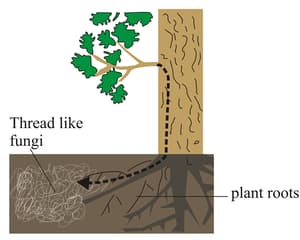
What is nutrition? Explain the difference between autotrophic and heterotrophic nutrition.
Why do plants show better growth in early hours?
Demonstrate with the help of an experiment that:
Carbon dioxide is essential for synthesising food by green plants.
How do we differentiate between symbiont and saprotroph?

